In this guide, you’ll explore the top 17 beginner-friendly floating aquarium plants. These selections are not only low-maintenance but also highly effective at enhancing the health and aesthetic of your tank. From the fast-growing Mosquito Fern to the vibrant Red Root Floater, each plant offers unique benefits.
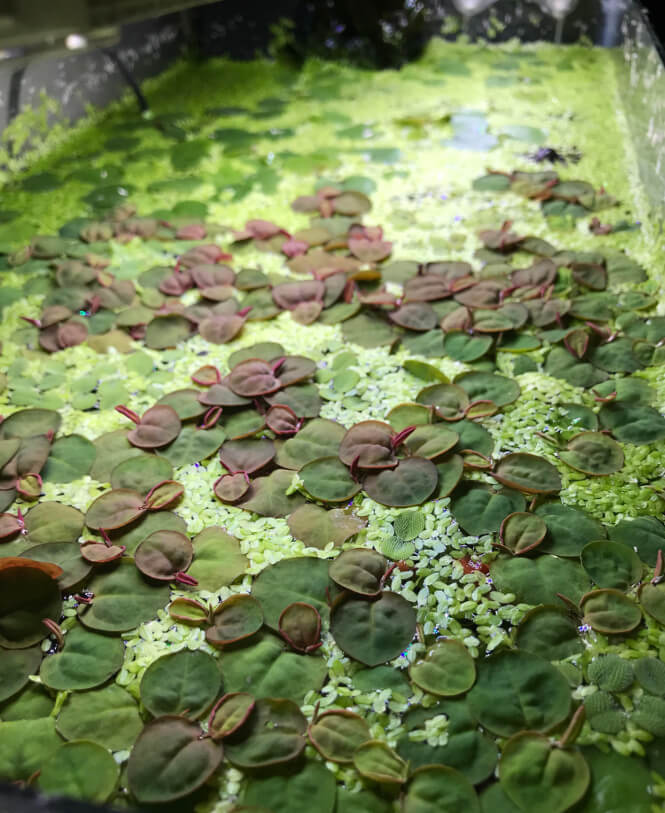
Did you know that a single aquatic plant can make a huge difference in your freshwater fish tank?
Aesthetics aside, the 17 floating aquarium plants I’m about to list are:
- Great stress-eliminators for Betta fish;
- A refuge for newborn fry or shrimp;
- Excellent in controlling Nitrate levels.
In this article, you will learn about the floaters that are a great option for starters who have just begun to incorporate vegetation in their aquarium.
For this reason, most of these live aquarium plants are easy to take care of, and have low light requirements.
However, pay close attention as some of the entries on this list will rapidly cover the water surface of your freshwater aquarium.
So let’s get to the point and find out which are the best floating aquarium plants that would best suit the beginners in the hobby.
The Top 17 Floating Aquarium Plants for Beginner Aquarists

Floating plants are a great addition to a freshwater fish tank because they aggressively feed off the water column and are therefore great at controlling excessive nutrients.
Even though that’s not their only benefit it certainly is a nice addition to their aesthetic looks.
That being said, have a look at the 17 best floating aquarium plants:
1. Mosquito Fern – Azolla filiculoides
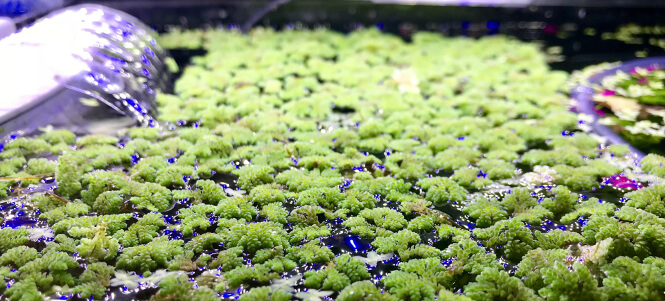
The floating Mosquito Fern plant will spread rapidly in a freshwater aquarium, because of its ability to accumulate Phosphorus and Nitrogen extremely well, directly from the water. The Mosquito Fern comes from the Azolla genus, species of which have been used for years as a companion plant in rice paddies, to fix nitrogen.
That particular trait makes the Azolla super efficient for combating aquarium algae.
That being said, the Mosquito Fern is an aesthetically pleasing surface plant, that can create one of the best display fish tanks.
The Azolla will extend a satisfyingly-textured rug on the top of the water if let loose.
When I was first observing its development I was stunned by the fact that it thrived without taking any particular care of it (fertilizer, CO2 supplements, etc.).
The small patch of fern that I initially placed soon covered the entire water surface.
Have that in mind if you keep other plants below as they won’t have sufficient access to light.
Creating light pockets will be necessary.
I was removing some of the mosquito-repellent plants twice every week as part of my fish tank maintenance routine, which worked perfectly fine for the underwater plants below.
A friend of mine had her turtle pretty much do the trimming for her.
As a unique trait for floating aquarium plants, if provided with more intense light the Mosquito Fern’s green leaves will get this rusty-red shade. That happens because of a symbiotic relationship with a type of cyanobactrium.
2. Mosaic Plant – Ludwigia sedioides
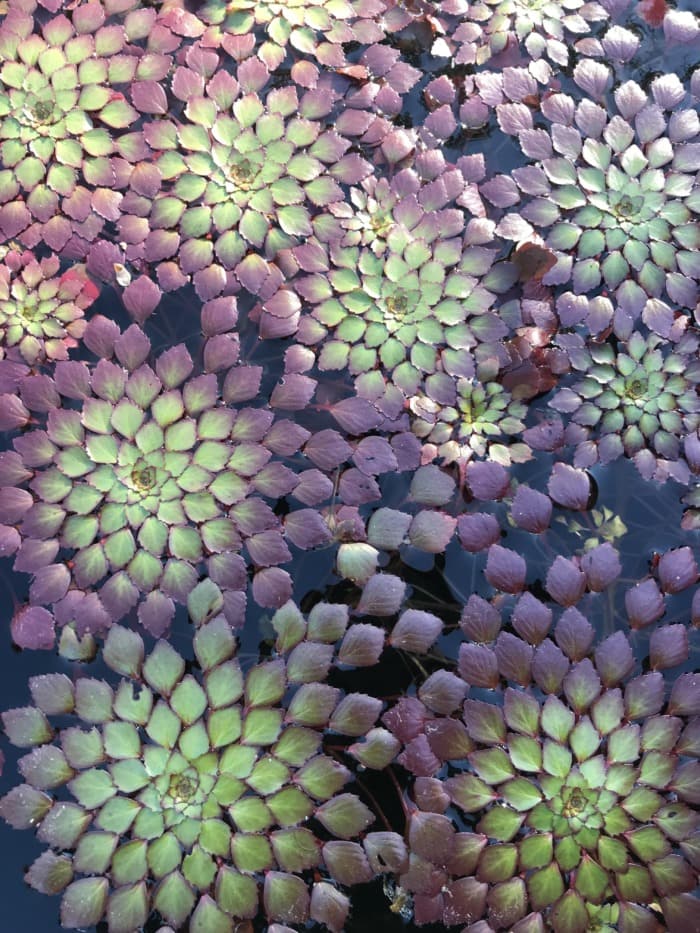
With its unique leaf shapes and low demand the Mosaic Plant is probably one of the best floating plants you can try in your aquarium as a beginner.
The Mosaic Plant is a member of the Ludwigia genus, mainly distributed in tropical regions of Central and South America.
I can’t believe I did not include this plant when I first wrote this article.
My reasoning was that technically you need to plant it in the substrate and let it reach the surface.
Fortunately, a reader noticed it in my Pinterest photos and made a point in the comment section that I should include it in this list (thanks, Beth!).
Anyway, I first got my hands on the Mosaic Plant after I bought it from a local pond store.
It’s usually classified as a pond plant, but I asked around and it turned out it does well in aquariums too.
Naturally, seeing how beautiful the mature ones looked, I went ahead and planted my new Mosaic Plant in the substrate, as with every other stem plant.
To be honest, at first, it did not look like much. You can expect to see something like this:
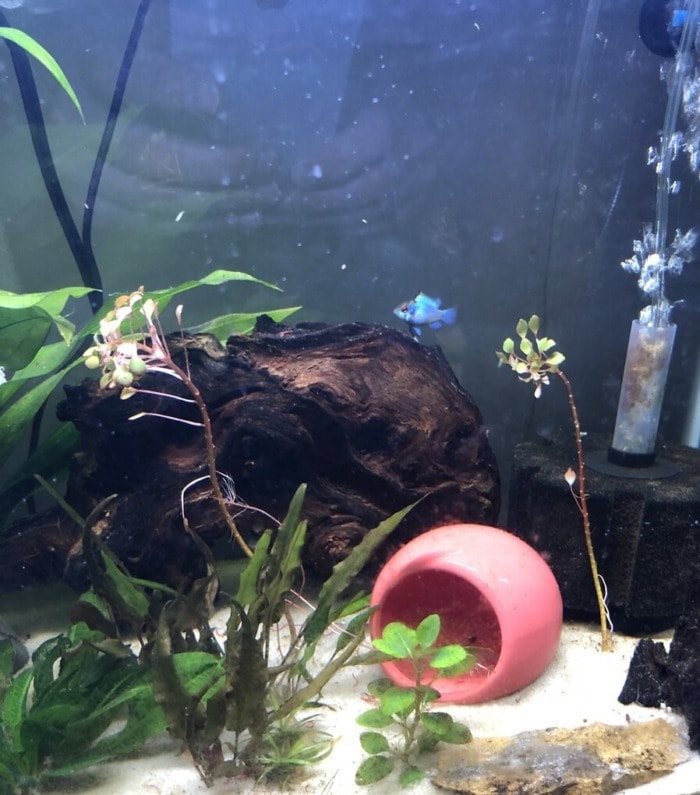
In my experience, you’ll need to arm yourself with patience as this plant is not a fast grower when underwater.
However, once my little Mosaic Plant reached the water’s surface I was convinced the waiting was worth it.
It started spreading nicely and made for an extremely attractive floater because of its surreal-looking leaves.
I recommend trying the Mosaic Plant if you have the patience but want a more unique look for your planted tank.
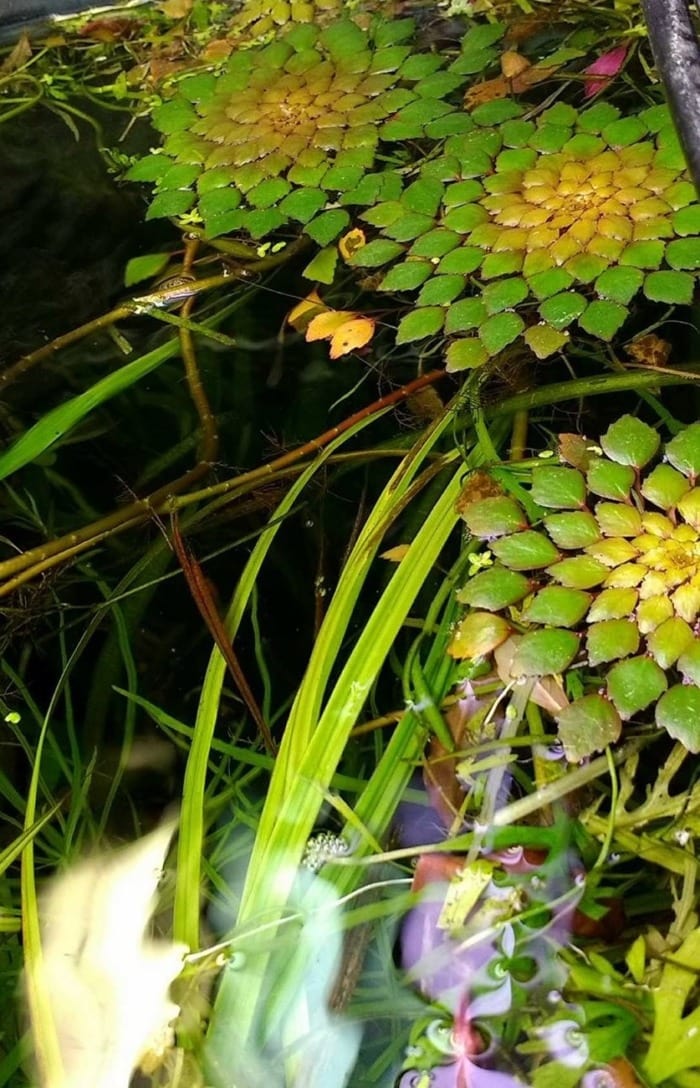
Author’s note: Although I list this plant as beginner-friendly there is one ingredient that you’ll need to have for it to grow and show its nice red-ish colors. Namely, a good lighting fixture that provides strong illumination.
In my next entry, I have a link to my guide on aquarium lighting for plants.
Do give it a skim if you want to be able to grow more than just the basic plants.
Enhance coral health and growth by exploring this article on ideal SPS and LPS coral foods.
3. Red root floater – Phyllanthus fluitans
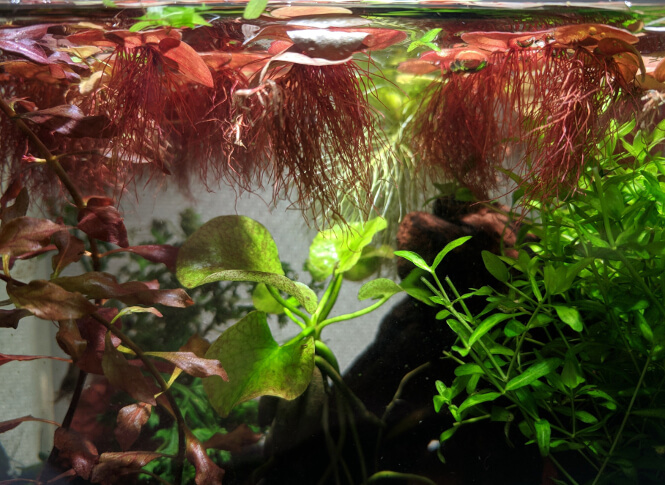
The red root floater is another live aquatic plant that will stay on the water surface of a fish tank.
This plant is part of the Phyllanthus genus, which includes a wide variety of species. It is also, in my experience, a great red plant to add color to your tank.
However, it’s not a common choice among aquarists, which is somewhat baffling to me.
It has a sound root structure, descending into the water beautifying the top of the aquarium with its vibrant red coloration. The gentle leaves of the red root floater are green, but if there is a high light source such as good LED grow lights for extended periods of time they will acquire this beautiful pink to red tint.
The red root floater is a flowering floating plant, which is another reason for adding it to your freshwater fish tank.
Its flowers are rather tiny, with pink-tinted petals and yellow stamens. To get your Red root floater flower you should provide high light, a slow water flow, and an iron supplement as fertilizer (Seachem Flourish Iron does wonders, you can check it out in this link to Amazon.com).
The colorful red roots are among the best shelters for newly-hatched fry fish.
4. Common Salvinia (Water Spangles) – Salvinia minima
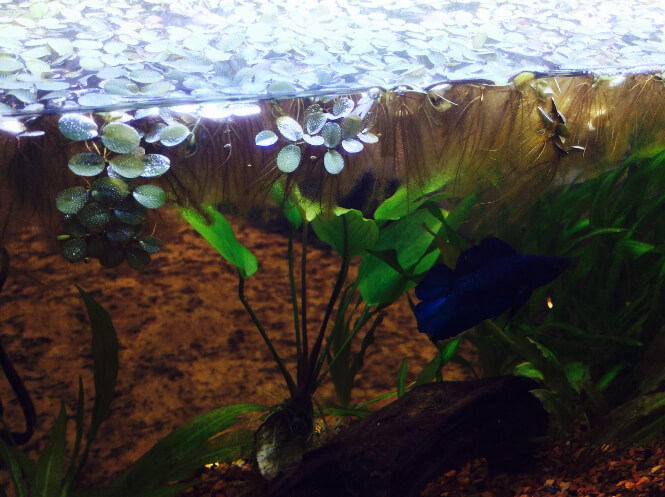
The Common Salvinia belongs to the Salvinia genus, commonly known as Watermoss.
I love Salvinia’s texture – its leaves are covered in fine hairs that give it a particularly satisfying look.
It has a rather short root structure, which makes shrimp swim to the water surface where the roots are freely hanging.
Freshwater shrimp love taking their time to clean the roots.
Common Salvinia spreads quite fast, so you need to keep an eye on it and take out amounts of it on a regular basis, which is quite an easy job to do.
This way you are making sure that the plants below in need of light won’t get neglected.
That being said, the Common Salvinia is a live floating aquarium plant that’s one of the best at sucking nitrates straight out of the water column.
The Salvinia Minima is also hardy and the only thing you need to know in regard to its care is that the higher the water agitation, the smaller the leaves will remain in their full-grown state.
5. Water Sprite – Ceratopteris Thalictroides

Coming from the Ceratopteris genus, the Water Sprite as it’s more commonly known is one of my personal favorites on this list.
You can grow it both rooted in the substrate or floating, but in my experience, it does better floating.
It is easy to take care of and it grows astonishingly fast.
It does need maintenance, as in the case where you don’t trim it for some time, it will take over the whole aquarium water surface.
What I love about the Indian Fern (Water Sprite) is also the fact that it is like a sponge for fish tanks that have algae issues or have just been set.
It will protect the fish from nitrogen poisoning in the beginning stages of the development of stable water chemistry.
The Water Sprite is the best floating aquarium plant for keeping guppies because it develops a root structure that provides shelter for guppy fry. Meanwhile, the leaves on top give a pleasing filtered shade to the aquarium making the guppies feel safer and less stressed which contributes to showing more of their personality.
Guppies won’t try to eat the Water Sprite, unlike other fish or snails.
In case you keep plants rooted in the substrate that also don’t enjoy as much light (such as Anubias), the Water Sprite is a great addition to your planted tank.
6. Anacharis plant – Egeria (Elodea) Densa
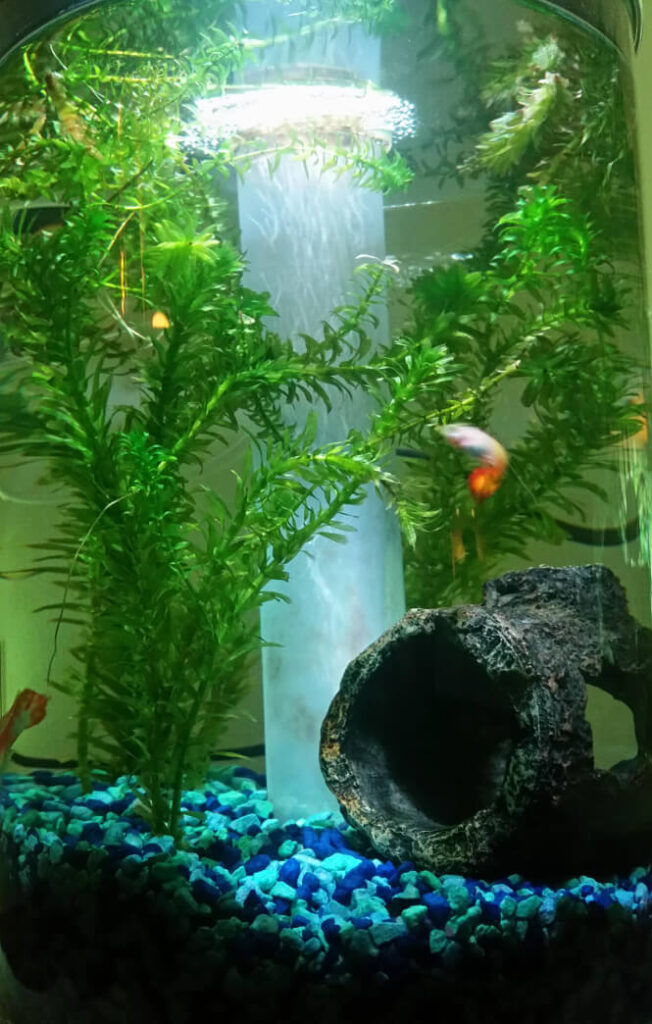
The Anacharis is a widely-spread choice as a beginner-friendly floating plant.
This plant is a member of the Egeria genus, previously included in the related Elodea genus.
Often after floating for a while it naturally roots itself in the substrate.
Of course, if at some point you don’t want it floating around, you can attach it yourself.
It will thrive if you keep the lighting at medium to low levels and the water at a bit lower temperature – between 70 and 77°F.
The Elodea is famous for its oxygenating qualities and rapid reproduction.
Anacharis is most likely the best floating plant for aquariums that contain goldfish. Both the plant and the fish have similar water temperature requirements. Goldfish will enjoy nibbling on the Elodea’s leaves but Anacharis grows very fast.
The nibbling of the goldfish won’t have a significant impact on the plant’s health.
Even if the Anacharis is being planted in the substrate and the goldfish uproots it (typical goldfish behavior), the plant will survive because it does well while floating.
7. Mini Pellia – Riccardia chamedryfolia

This beautiful liverwort will embellish your aquarium as soon as you place it inside it.
Coming from the plant genus known as Riccardia, the Coral Moss (another name for this floating plant) has a lovely delicate look and a beautiful green color.
The Mini Pellia can be kept free-floating in your freshwater aquarium, but after a while, it will grow, and densify, its weight making it sink.
Mini Pellia in aquascapes is usually attached to driftwood, rocks, or stainless steel mesh.
It has an attractive dense composition.
The Mini Pellia is considered the best floating plant for shrimp-centered tanks. Shrimp fry appreciates the shelter that the Mini Pellia is providing.
Fully grown shrimp are compelled to crowd up on top of this floating plant, actively grazing on it.
The green color of the Mini Pellia and its clean and compact look also enhances the coloration of aquarium shrimp.
You should bear in mind that this floater thrives at a lower temperature (72 – 76°F) which is also beneficial for breeding shrimp, because this temperature range decreases the chance of bacterial infections. This surface freshwater plant is a bit more on the expensive side, however.
Patience is key with Mini Pellia as it grows slowly, but its beauty is absolutely worth it.
8. Dwarf Water Lettuce – Pistia stratiotes

Another surface floating plant that develops a bushy root structure is the Dwarf Water Lettuce from the Pistia genus of aquatic plants.
It has thin leaves with tiny hair covering them.
You should provide moderate to high light and low flow for your Dwarf Pistia to thrive.
The choice of good lighting will impact its wellness and growth the most.
If kept under proper conditions the roots will grow along with many fine branches, which requires a deeper tank.
If this freshwater plant feels well it will stretch its water surface coverage and you will need to take out some of it away from time to time.
The Dwarf Water Lettuce is generally considered to be among the best floating plants for a betta fish. The leaves of the plant imitate the natural habitat of the betta, making it feel less stressed and more comfortable.
Bettas benefit from the long root structure of the Dwarf Water Lettuce and feel comfortable swimming around it.
When the betta is not stressed it has more pronounced colors and a longer lifespan in general.
Bear in mind that there should still be some space uncovered by the plant, as bettas breathe atmospheric air and would need access to the water surface.
Dwarf Water Lettuce is also a great addition to your divided breeding fish tank for bettas.
Just place it in the female compartment and it will provide places for the female to hide from the male.
Author’s note: Another interesting fact about the Water Lettuce is that it is one of your best bets if you want floating plants in a turtle tank. This is usually done as a preventative measure against green turtle tank water.
9. Foxtail Plant – Ceratophyllum demersum
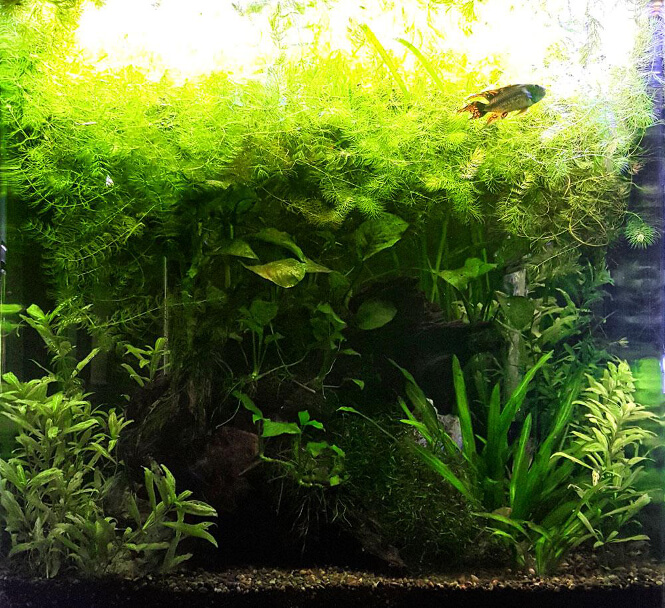
The Foxtail Plant, also known in the hobby as Hornwort, belongs to the widely distributed Ceratophyllum genus. It is another great floater, that controls ammonia or high nitrate. Thus it successfully fights off most types of aquarium algae.
Research suggests that it can even strip your tap water from toxic metals. You can obey nature and leave it floating, or you can also be planting it on the substrate.
Other methods of keeping it include wedging it between rocks or just using suction cups and fish lines to position it the way you’d like.
The Foxtail plant is a great novice-friendly fast grower that can safely float in low-tech aquariums.
The Hornwort is among the best and most frequently chosen floating plants for fish breeding tanks. Its bushy foxtail-like structure provides sufficient cover for fish and shrimp fry alike.
If you keep livebearers and you’re trying to save the next generation, or if you’re trying to breed shrimp in an aquarium stuffed with community fish then the Hornwort plant is the answer.
10. Floating Crystalwort – Riccia Fluitans

You will often see The Floating Crystalwort used as an aquarium carpet, but its natural state is to be floating on the water surface.
The Floating Crystalwort is a part of more than 100 species in the Riccia genus.
If you decide to attach it to hardware, bear in mind that you would most likely need to take it out every other day.
Re-tie it again after, to keep it attached and neat-looking.
Riccia is strongly determined to reach the surface of your aquarium.
In case you want to have it submerged and put in the effort to attach it to the bottom of the aquarium, your patience will pay off. Shiny microbubbles will pop out on the plant’s texture, creating a beautiful pearl garden.
Crystalwort is a fast grower, especially when supplied with CO2 and sufficient lighting. Shrimp love it and it is a great hiding place for fry and small fish.
When left floating Crystalwort casts a nice dappled shade, that’s greatly appreciated by the aquarium inhabitants as it resembles their natural freshwater environment.
11. Moneywort – Bacopa Monnieri
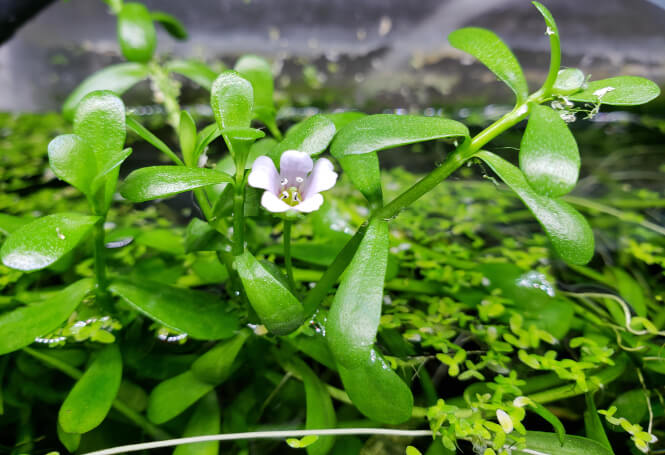
The Moneywort from the Bacopa genus is a wonderful plant that does extremely well when kept floating on the surface of your fish tank.
You can root it in the substrate as well, however, I prefer keeping it as a floater.
It will spread horizontally and will provide partial shade.
The Moneywort can serve as a great shelter for fry in the community or breeding aquariums. It can attract some algae to its roots but a cleaning crew of shrimp or mollies can take care of the intruder.
The Bacopa Monnieri gorgeously enriches the aquascape and can also produce quite attractive flowers.
12. Water Wisteria – Hygrophila difformis

The Water Wisteria is a member of the Hygrophila genus, many species of which are aquatic plants.
If kept as a floater the Water Wisteria will grow curved stems across the surface of the aquarium with its roots hanging down.
It might even grow emersed leaves, which are quite enjoyable to observe.
You can plant it in the substrate too, and this way it will grow straight up, trying to reach the light.
When being planted its leaves towards the bottom of the stem might turn yellow, so you will need to occasionally remove them.
In my experience, this freshwater plant grows faster when floating and not when planted.
You will need to cut and take off some of it to reduce its surface coverage.
Baby fry find asylum in its long thin roots by definition.
Also, if you have a betta fish the Water Wisteria serves as a stress-reducing factor in its aquarium.
13. Amazon Frogbit – Limnobium laevigatum
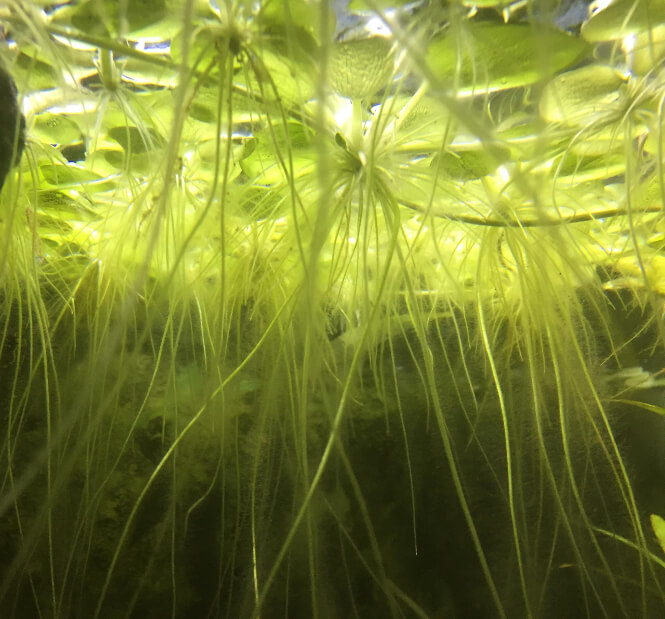
The Amazon Frogbit is a lovely beginner-friendly plant that floats used in freshwater aquariums, because of its ability to purify water from harmful chemicals . This floater from the Limnobium genus will eventually cover the entire water surface of your fish tank with its green oval leaves.
The Frogbit plant has among the longest and most attractive-looking roots, which are greatly appreciated by all species of freshwater aquarium shrimp.
The more light the Amazon Frogbit receives, the longer the roots will grow, reaching deep beneath the water surface.
A Frogbit doesn’t like too much water agitation, and just like the Red Root Floater – the leaves on top should generally remain dry.
Don’t encourage splashing surface waters to avoid rotting.
It will spread relatively fast, providing a dense cover to the aquarium.
You will need to take out some of it every week or two, which is quite easy due to its size and composition.
Bear in mind that after you place it in the fish tank the Amazon Frogbit will most likely need a few weeks to acclimate.
Don’t worry too much if it’s not developing at a fast pace in the beginning.
A couple of months later you will find yourself regularly taking chunks of it out, so the Frogbit doesn’t block all of the light that is needed below.
14. Giant Duckweed – Spirodela polyrhiza

The Giant Duckweed comes from the Spirodela genus, one of a couple genera including plants, also known as duckweeds.
No matter what others advise you it has been my experience that Giant Duckweed is the best variation of duckweed species for a home freshwater aquarium.
The Lesser Duckweed is truly invasive and annoying for all fellow hobbyists because it affects the filter and they have to scoop it out on a regular basis.
When they finally decide it’s time to get rid of it completely – it may seem impossible.
It is a great floating aquarium plant for beginners and it thrives even in low lighting.
All of this while doing a great nutrient control job for your aquarium water.
Some fish love to eat it (Goldfish for example), so in case you have more than one tank you can relocate the excess bits in your goldfish tank and observe the feast that ensues.
The Giant Duckweed also makes shy fish feel less anxious encouraging them to spend more time near the top of the aquarium.
It also serves as a very protective shelter for baby fish and shrimp.
The Giant duckweed is highly underestimated, so don’t exclude it as an option, just because it has “Duckweed” in its name.
15. Asian Watergrass – Hygroryza Aristata

The Asian Watergrass is the most unique-looking floating plant that you can come across.
It is the only species of grass from the Hygroryza genus in the grass family that can be kept in a home freshwater aquarium.
It is needier than most other plants mentioned in this list.
It does require high amounts of light to thrive.
If its needs are met it spreads fast, growing in a creeping manner covering the aquarium’s water surface with its new stem fragments.
You will need to prune out the excess stems from time to time to have some light coming in for your other plants beneath.
I love the particular look of this plant and the fact that it stands out among the common species that you might come across on most forum recommendations.
It has these branches that grow diagonally to the sides of the stems and each branch has an ellipse-shaped green leaf that reaches 4 inches in length.
The Asian Watergrass forms a long bushy root structure that hangs down the water column.
Hygroryza Aristata is not as available as most floating freshwater plants mentioned here, but keep your eyes open for this uncommon addition if you want to stand out from the crowd.
16. Brazilian Pennywort – Hydrocotyle leucocephala
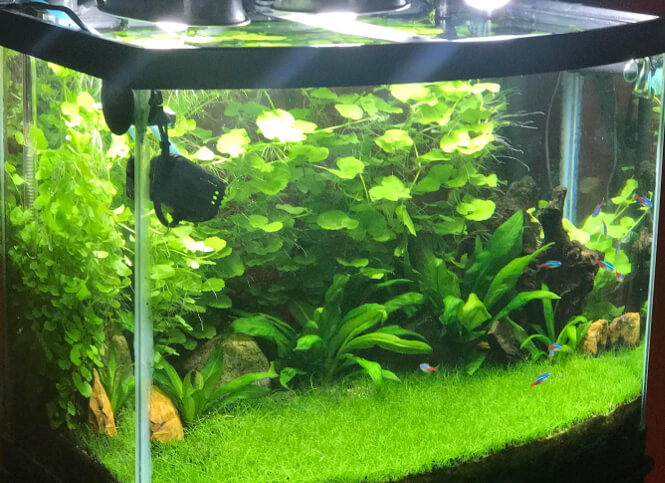
The Brazilian Pennywort, assigned to the Hydrocotyle genus, has light green leaves that are round in shape.
It can cover the water of your open-top freshwater fish tank, creating a beautiful “green ceiling” effect.
It’s not a difficult live plant to look after and it will do just fine in low-tech planted aquariums.
You should, of course, bear in mind that the stronger the lighting, the faster the growth of your Pennywort will be.
It’s very likely for a Brazilian Pennywort to emerge above the water surface and even start creeping on the sides of the aquarium.
If it’s doing well it might also flower, which is always exciting for someone that has watched the Brazillian Pennywort grow from a tiny stem.
17. Indian Toothcup – Rotala Indica
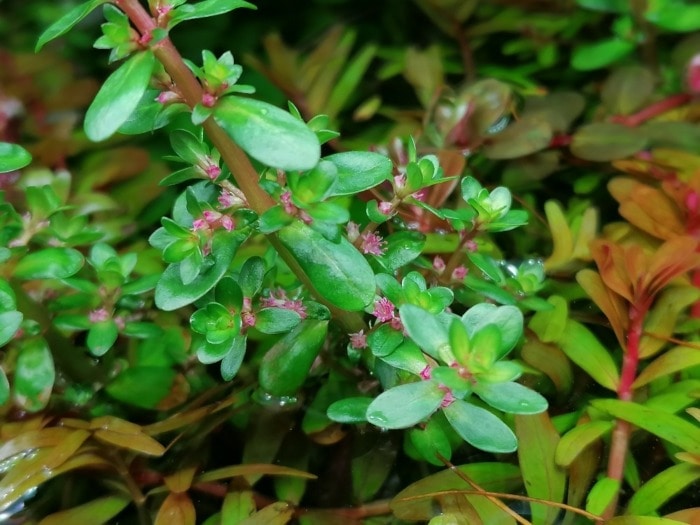
The Indian Toothcup from the Rotala genus is an undemanding plant that’s relatively easy to care for.
It has minimal light requirements, grows extremely fast, and propagates effortlessly.
With sufficient lighting and CO2 injections, it can even develop beautiful red leaves.
Since it has a rapid growth rate, the Rotala Indica requires regular trimming and is best suited for larger tanks.
Therefore, I wouldn’t advise having it in aquariums smaller than 20 gallons.
It’s worth pointing out that the Indian Toothcup can also be planted in the substrate as a background or midground plant.
Just something to keep in mind if you’re running out of ideas.
Less-known benefits for the aquarium
Floating aquatic plants are not as valued as they should be in the aquarium hobby.
I don’t see them in freshwater aquariums as much as I would like to, even though their qualities significantly outnumber all that you might have against them.
Here are notable benefits of having floating aquarium plants in your freshwater tank:
- Algae control.
Floating plants uptake their nutrients straight from the water column and serve as a filter for excessive nitrates and phosphates. This balances the nutritional density and prevents algae from exploiting leftover plant food.Therefore floating plants are great at out-competing algae and immensely help with the control of outbreaks. I’ve recommended using floaters against both microalgae blooms in the aquarium water and Black algae infestations.
- Oxygenating the water.
Through photosynthesis floating plants release oxygen straight into the water during the day, maintaining the oxygen concentration at a healthy level for your fish. - Reducing stress for fish.
Floating plants cover the aquarium surface creating a natural shade, which provides comfort for most freshwater fish and reduces stress.Fish feel looser and cozier in their tank, swim more often near the surface, explore their environment more, and start showing off their personality.
Reducing stress levels in fish also means that their colors will be enhanced. Floating plants are often a good choice if you have a small tank with tiny fish.
- Shade for other aquatic plants.
The shade that a live floater plant provides is beneficial for the development of the bottom plants that have low-light requirements.Having a floater gives the opportunity of diversifying the light penetration at different parts of your aquarium, which means that you can have both low and high light-requiring live plants.
- Providing fry shelter.
Floating plants ensure fish and shrimp fry protection.Some floaters, such as the Red Root Floater, the Dwarf water lettuce, and Water sprite develop densely structured long roots where baby fry hide.
- Beginner-friendly maintenance.
Most floating plants are a great pick for beginners in the hobby, who don’t have experience with live plants and want to try them out.Floaters aren’t demanding – most of them don’t have high-light requirements.
They obtain the essential Carbon Dioxide straight from the air, so as long as there’s no aquarium lid, they will do fine.
- Great aesthetics.
Floating plants uniquely enrich the aquascape.They are a great addition to open-top tanks and create a beautiful green ceiling.
When in combination with bottom plants the floater’s roots and emersed leaves will recreate a layered vegetation forest that brings wilderness to your home aquarium.
- You can sell them.
Most floating plants are fast-growing and easy to keep.You will often have to take out some of your floating plants of choice, as you wouldn’t want them to cover the whole water surface.
If you have a local fish keeping community you can always share what plant you have in excess and send it over to a fellow hobbyist in exchange for another plant or just sell it at a price of your desire.
Which floating plants would be the best for a beginner and are easy to look after?
If you don’t have any experience with freshwater aquarium plants, floating plants are a great way to get started.
Not all floaters are perfect for beginners. Below you can find which are the best floating live aquarium plants for a beginner:
Most of the floaters are a perfect pick for a beginner aquarist as they are easy to take care of, have low lighting requirements, and will grow healthily in low-maintenance aquariums.
Seeing your floater thrive will give you the experience of having a live plant in your freshwater tank and will most likely spark your interest to incorporate more living plants in your aquascape.
Some great beginner floating aquarium plants are:
- Giant Duckweed;
- Common Salvinia;
- Water Sprite;
- Amazon Frogbit;
- Foxtail plant;
- Mosquito fern.
Here’s a top view of an aquarium that has a combination of different floating plants including a flowering red root floater:
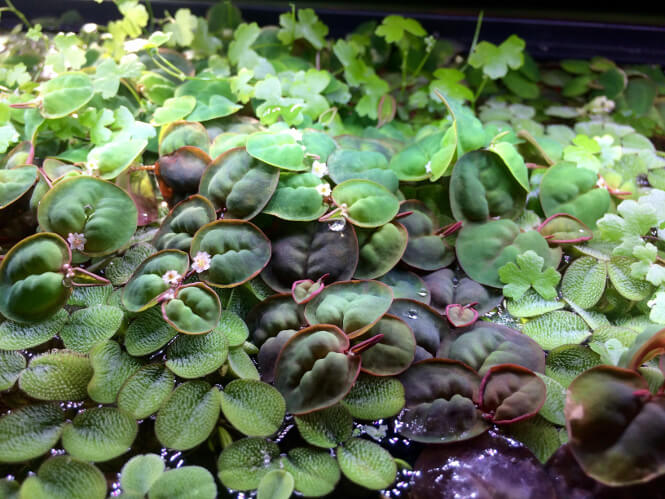
Is it safe to purchase your aquarium plants online?
It is always better to have your plant purchased from a local fish store.
This way the plant wouldn’t have traveled for a couple of days tossed around in a box.
The truth is though, that many times your local store wouldn’t have the plant selection of your taste available.
This is why most of the time purchasing live aquatic plants online is the only way you can have the floater you desire. The most important thing here is to choose the right seller.
This means that the provider should take packaging seriously, as sometimes plants in perfect condition that are not properly packaged get ruined in a day’s worth of time.
I say that as I can’t count the times my less-experienced friends have ended up with a Lesser Duckweed invasion after having ordered some frogbit.
Of course, the well-being of the plant also depends on the weather.
You should avoid placing an order when it is too hot or below 30°F, as even with great packaging the plant may arrive damaged.
I’ve chosen my first supplier based on online reviews and a friend’s recommendation as I don’t like depending on luck.
Given that you’ve also chosen the right seller you can safely purchase your floating plant on Amazon or elsewhere.
When it comes to suppliers I can recommend two that I’ve found to be quite reliable. They are this one and that one (both are Amazon sellers).
There are also other vendors that sell aquarium plants on the Internet and you can check them out in my guide on the best online fish and aquarium stores. Anyway, most floaters spread rapidly, so after getting started you will most likely find yourself throwing away a good amount of your new floating plant on a regular basis.
This is why a lot of times members of fishkeeping communities would exchange different plants and even send floaters away for free.
So in case you have friends that are into fishkeeping or you are a regular visitor of forums and Facebook groups, look around for someone like that.
Many of my floaters I’ve had delivered after arranging an exchange.
My Final words
There are too many advantages to having a floating plant in your freshwater aquarium.
It’s good-looking, exotic, relatively easy to take care of, and beneficial for algae control.
Of course, as with every other thing in fishkeeping – they do need attention to a certain extent – be it trimming them or taking some out to avoid a full aquarium eclipse…
So, tell me in the comment: which one did you choose for your fish tank?
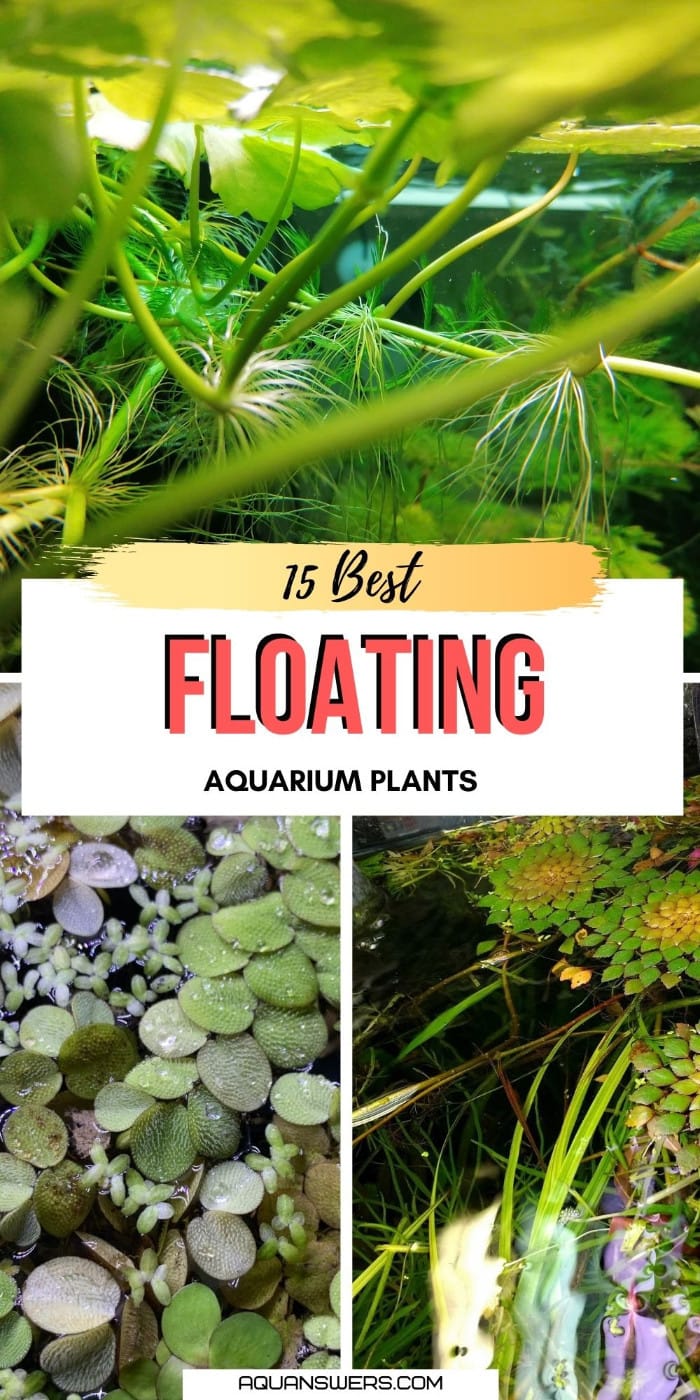

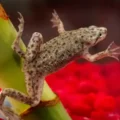
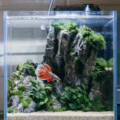
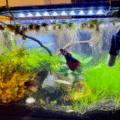
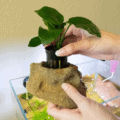

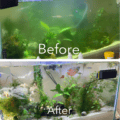
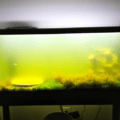

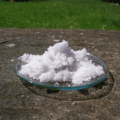
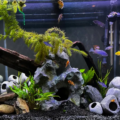
I just purchased a floating plant I forgot what it was. I have black fungus on some of my java and anabis, I’m going to soak them in hydrogen peroxide, as you explained. How do you keep the floaters from being sucked into the filter? (Fluval 307).
Hi,
To stop my floating plants from clogging the filter, I have a DIY floating barrier from simple tubing and some super glue.
Are any of these plants cold hardy?
I live zone 8 and currently just have water lilies in my pond
Right above the comments you have 3 plant pictures w/the box that says “15 Best Floating Aquarium Plants”. I want to know the name of the yellow & green plant floating in the Bottom Right Picture? Can you email me the answer & add it here? Thank you. 🙂
Hello Beth,
Sure – this floating plant is known as the Mosaic Plant or Ludwigia sedioides. 🙂
Best,
Momchil
Update: I added the plant to the list. Thanks.
Great list. I am keeping Cardinal shrimp right now. But I have Blackbeard algae forming in the tank. I am thinking to get a couple horned nerite snails and maybe some floating plants like the red root floaters. I am also thinking to put some Christmas Moss or mini pellia on a bonsai tree in there. I’ve also thought about doing a 48-hour blackout to get rid of it. But I don’t want to upset the balance of the tank or kill the other algae that is in there because the shrimp feed off of that. What do you think?
Whenever i get a live plant, pieces of it go into my filter. It is hard to clean. those are plants that on the bottom, not floating. is it the same problem? my fish nibbles on it all the time.
Hi Susan,
I’d say that the problem is the nibbling. Some fish just can’t help it… Thus some aquariums are best kept without live plants in them.
Very informative and an enjoyable read. I’m a houseplant fanatic but only have plastic plants in my tank. My question is can floating plants live with a lid on the tank?
Thanks!
Hi Tracy,
In my experience, lids could cause the build-up of humidity so much so that it may cause the plant to rot (ironically). Also, let’s not forget that floating aquarium plants grow so fast because they have easy access to the atmospheric CO2. This access will be limited with a lid. If the water surface is too close to the cover, the humidity will be an issue. You could try a lid with some ventilation holes and see how that works.
Assuming that jumping fishies are what pushes you to go for a lid – you can always try a net!
Good luck, looking forward to your reply.
Regards
Thank you for the quick reply! I have a lid on my tank because it came with one…is it not necessary??
I also have a light which straddles the aquarium top and assumed the lid would keep water from getting into the light.
A lid helps protect the light from water splashing on it. And it also keeps the water from evaporating out of your tank too quickly.
interesting read. I would like to try some floating plants with an oscar.
Thanks.
Definitely give it a try. 🙂